
To use this site, please enable javascript

To use this site, please enable javascript
The technological development of the maritime industry is moving faster than ever. Staying ahead and thus ensuring maximum gain of the possibilities this development brings, from the beginning, is vital to every organisation involved in operations at sea.
EIVA sees five decisive trends resulting from new and improved technologies. In this last piece of the series, our CEO, Jeppe Nielsen, dives into the very interesting benefits brought to the industry by deep learning technology.
Author: EIVA CEO Jeppe Nielsen
One of the monumental trends seen in the IT world in recent years is machine learning. Simply put, machine learning is an application of artificial intelligence. It focuses on the development of algorithms that can interpret data and learn from the data in order to apply this knowledge to make informed decisions – that is, the machine is trained using data.
Deep learning is a subfield of machine learning, taking the technology to the next level by making the software able to learn by itself – as opposed to being told how to make a prediction or decision, which is the case for the machine learning model.
(Learn more at https://www.zendesk.com/blog/machine-learning-and-deep-learning/ and https://blogs.nvidia.com/blog/2016/07/29/whats-difference-artificial-intelligence-machine-learning-deep-learning-ai/)
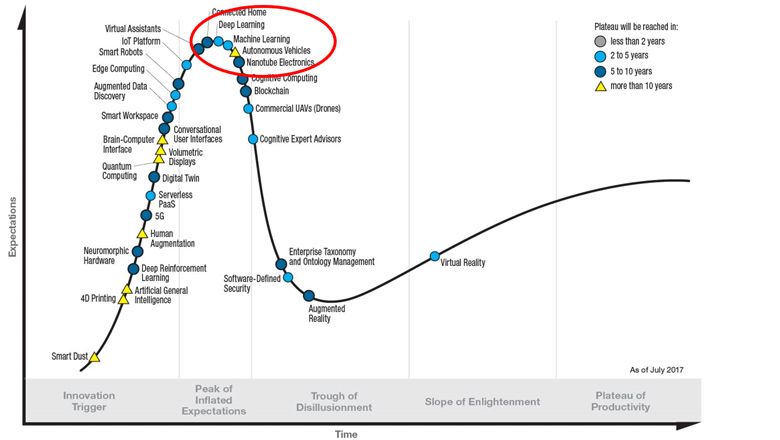
Gartner Hype Cycle for Emerging Technologies, 2017 (source: https://www.gartner.com/smarterwithgartner/top-trends-in-the-gartner-hype-cycle-for-emerging-technologies-2017/)
Looking at Gartner Group’s 2017 Hype Cycle chart, machine learning and deep learning are at their expectation peak and are expected to reach mainstream adoption in 2-5 years.
Neither machine learning, nor deep learning is a new discipline. The underlying technology of neural networks has been around for at least 25 years. However, it is in recent years that it has truly become productive due to gaining access to massive computing power, the development in affordable graphics/GPU performance and big data cloud infrastructures, and the massive amount of data available.
Deep learning is finding its way into many industries – including subsea and offshore segments. As it makes it possible to let software automatically recognise and localise objects in various types of data, typically photos and video. Deep learning has the potential to save companies specialising in for example pipeline inspections, habitat mapping or UXO detection countless hours of manual work – just to mention a few possible applications.
At EIVA, we wish to be part of driving this initiative as we constantly strive to provide the most efficient data processing and data interpretation platform for subsea-related data. Consequently, we established a dedicated software development team with engineers specialising in machine learning, machine vision and deep learning earlier this year. The team are now seeing the first results of their work, which are very promising.
NaviSuite Deep Learning is a black box software product that works in combination with the eventing features in NaviPac, the NaviSuite product for navigation and positioning, and NaviModel, which is dedicated to 3D/4D modelling and visualisation.
You can choose to apply it in three different ways, that is, as:
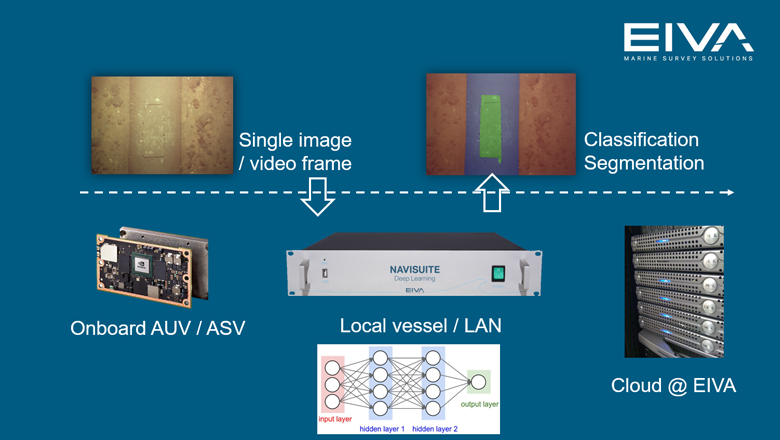
The same deep learning function is available through the cloud service, the rack server setup and the onboard computer setup
NaviSuite Deep Learning is based on a neural network model, which is trained on millions of various data samples from various providers, typically NaviSuite customers owning subsea assets. The resulting neural network consists of a set of parameters performing the actual object classification and segmentation.

Training the deep learning software based on millions of data samples from various providers
NaviSuite Deep Learning is very fast. The rack server is able to classify more than 500 FPS, that is, process some 500 images per second, where objects are identified and events are generated. Comparing this with a typical video stream of 30-50 FPS, a single NaviSuite Deep Learning rack server is easily able to process multiple video streams in real time and annotate each frame in the video with the objects that are detected. The onboard electronics version is able to perform 15-20 FPS, ie it can be used real time on video feeds.
Imagine the following usage scenarios:
For operations such as subsea pipeline inspections, NaviSuite Deep Learning can identify many different object types, including (but not limited to): pipes, anodes, joints, damages, boulders and debris.
For habitat mapping operations, we are looking for eelgrass, sand, rocks, gravel, muzzle banks, etc.
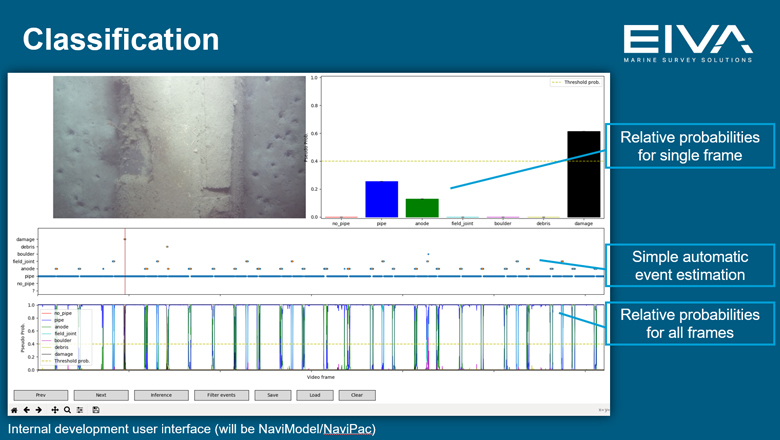
In this screenshot, NaviSuite Deep Learning has found the damage, the anode as well as the pipe in the picture (development prototype)
Initially, the deep learning software is working on video and still image sources, but we are currently gathering enough material to use it on intensity data (sidescan sonar and backscatter), terrain data (slope), and other sources.
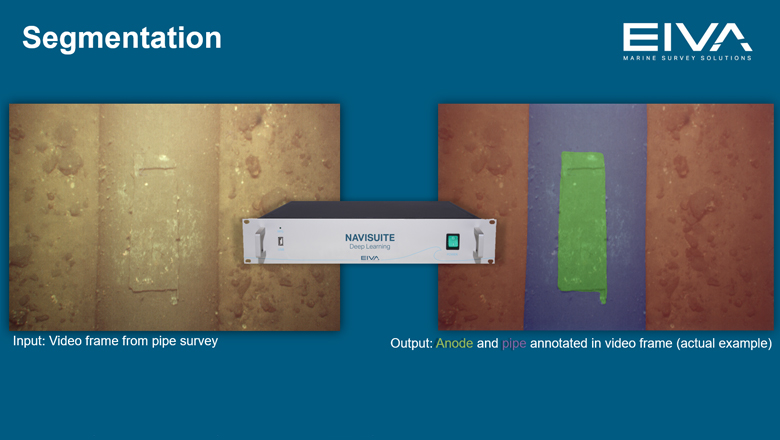
Here, the software has marked the anode and the pipe in the picture (pixel-by-pixel segmentation)
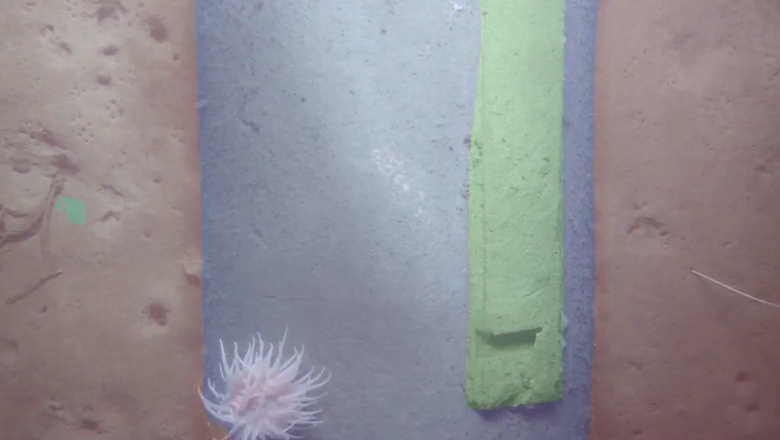
Pixel-by-pixel segmentation by NaviSuite Deep Learning
When using the NaviSuite Deep Learning software from within NaviPac or NaviModel, the classification software is working with the eventing and video functionalities of these products.
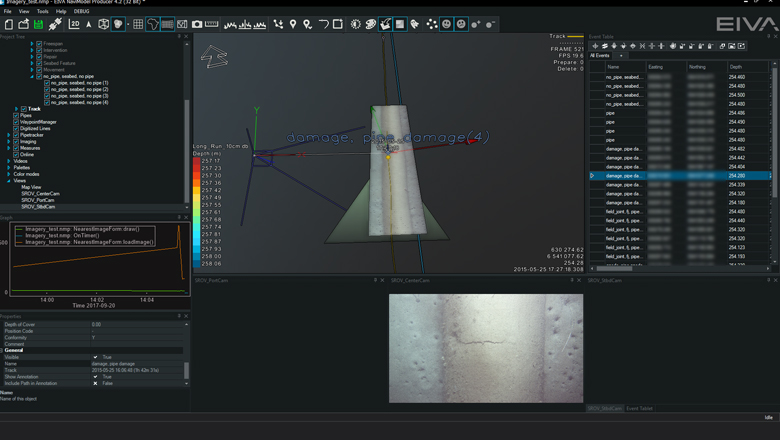
NaviSuite Deep Learning integrates with the eventing and video features of NaviModel and NaviPac Helmsman’s Display – here is an example showing an automatically detected event (pipe damage) generated in NaviModel
NaviSuite Deep Learning is available on an annual subscription basis. Subscriptions for rack server and cloud usage are priced at €9.995,- / year including 24/7 help desk support and all updates.
Rack server and onboard units are purchased in addition to the subscription. Retail price for the rack unit is € 5,000,- and onboard PCBs € 1,500,-.